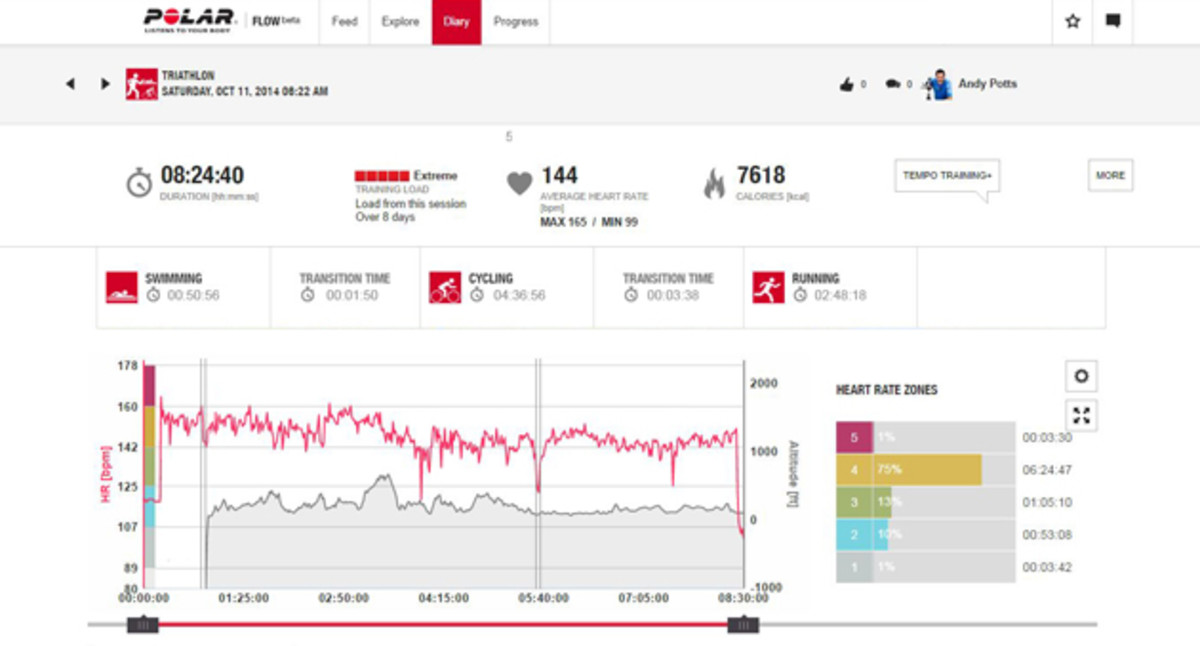Inside the heart of a champion: Andy Potts' Ironman race data

Do you ever wonder how difficult it is on a professional triathlete’s body to complete the entire 2.4-mile swim, 112-mile bike and 26.2-mile marathon in the Ironman World Championship race? American Andy Potts finished the race on October 11 in eight hours, 21 minutes and 38 seconds, earning himself a fourth place finish overall. With the help of Polar V800 technology, Potts’ average heart rate, calories burned and training load were tracked and calculated over the duration of the race. Potts talked with SI.com to help break down his data and explain the role nutrition plays in his fitness.
age | height | weight |
|---|---|---|
37 years old | 6-foot-2 | 167 lbs. |
Fitness Level: Elite professional athlete
Training for the Ironman World Championship
“My coach and I know exactly what is being required on race day from a physical standpoint because of the Polar watch, so we build my training to support that physiology,” says Potts. “You don’t go out and do an endurance race day after day—you break it up into pieces.”
Sebastian Kienle, Mirinda Carfrae conquer 2014 Ironman in Kona
Potts explains that endurance sports do not require an athlete to hit their maximum heart rate because of the long duration and physical demand of the races. (You can calculate an estimate of your maximum heart rate using the formula: 220 minus your age.) Instead, Potts works in heart rate “zones” based on his specific capabilities and fitness, with zone 5 being the highest heart rate zone.
“My coach will have me do six, one-mile repeats, and then we’ll wait until my heart rate drops 10-15 beats, and then go again,” says the 37-year-old. “Then we will assess how easy the effort was. My coach wants to see a faster pace, with the same heart rate and a quicker recovery.”
Evaluating Potts' race day performance
The graphic below illustrates Potts’ complete race at the Ironman World Championships. The gray lines denote his splits and indicate the transitions between swim, bike and run. The red line shows his heart rate and the grey line shows his altitude. The graph on the right shows how much time Andy spent in each of his heart rate zones.

Note: Potts had his heart rate monitor activated a few minutes before the race, which is why there is a slight jump at the beginning of the race.
| Bike | run | swim |
|---|---|---|---|
Overall rank: | 9th | 4th | 1st |
Total time: | 4:36:56 | 2:48:18 | 50:56 |
Transition times: (Swim-to-bike: 1 minute, 50 seconds) (Bike-to-run: 3 minutes, 38 seconds)
Total race time: 8 hours, 21 minutes, 38 seconds
How does Potts fuel his body?
After competing in the 2004 Olympics, collecting six victories in the Escape from Alcatraz Triathlon, winning the 2007 Ironman 70.3 World Championship and earning the title of fastest American (7th place overall) at the 2012 Ironman World Championship, Potts knows how to use nutrition to help fuel his body during workouts and on race day.
At this year’s world championships in Kona, Potts burned a total of 7,618 calories during his race, which is equivalent to about 27 slices of pizza or 14 Big Macs.
For his usual day-to-day diet, Potts has a huge meal after a good night’s sleep to give him the fuel to be able to handle the workload of the day. As the day goes on, Potts tapers off his carbohydrate intake and increases the amount of protein. For breakfast, he will have three bowls of cereal: the first is his choice, the second is always Raisin Bran and the third bowl is eaten sans milk. Potts’ lunch is typically a sandwich with a pickle, pretzels and a piece of fruit, and for dinner, a combination of chicken, quinoa and asparagus.
“I’m conscious that I am sometimes in a calorie deficient mode,” says Potts. “But as long as it keeps me fueled for the workout I’m okay. And it keeps me lean, which is good because I like to eat.”
